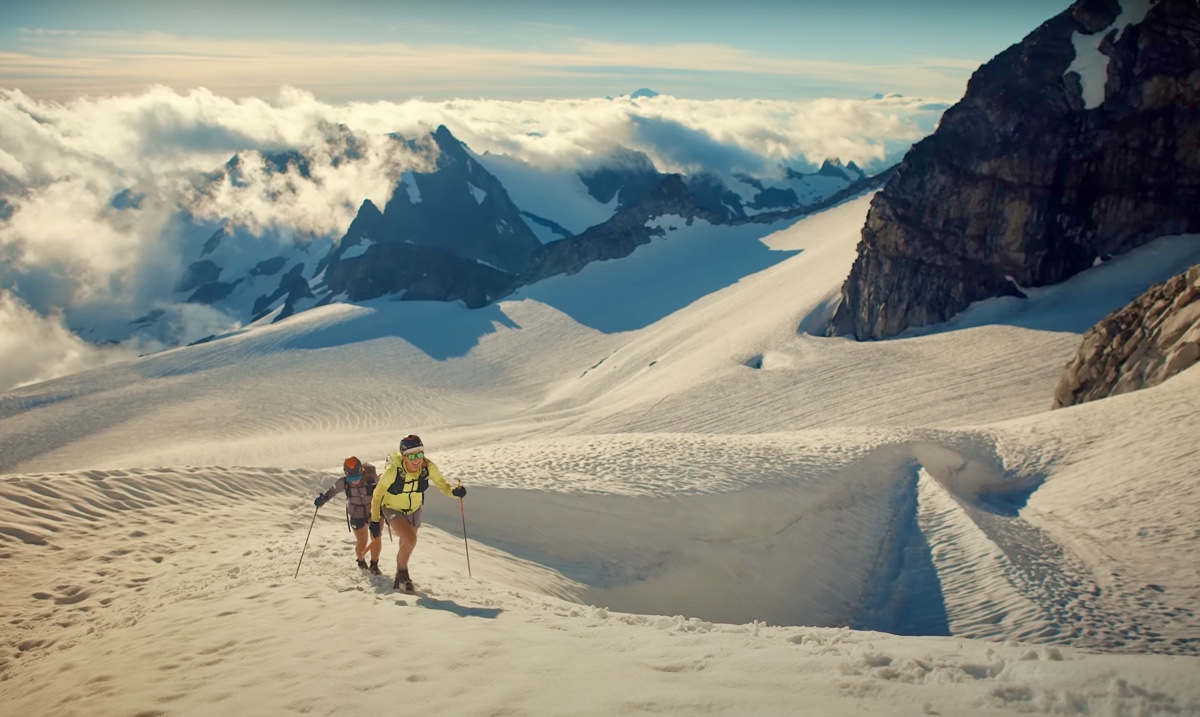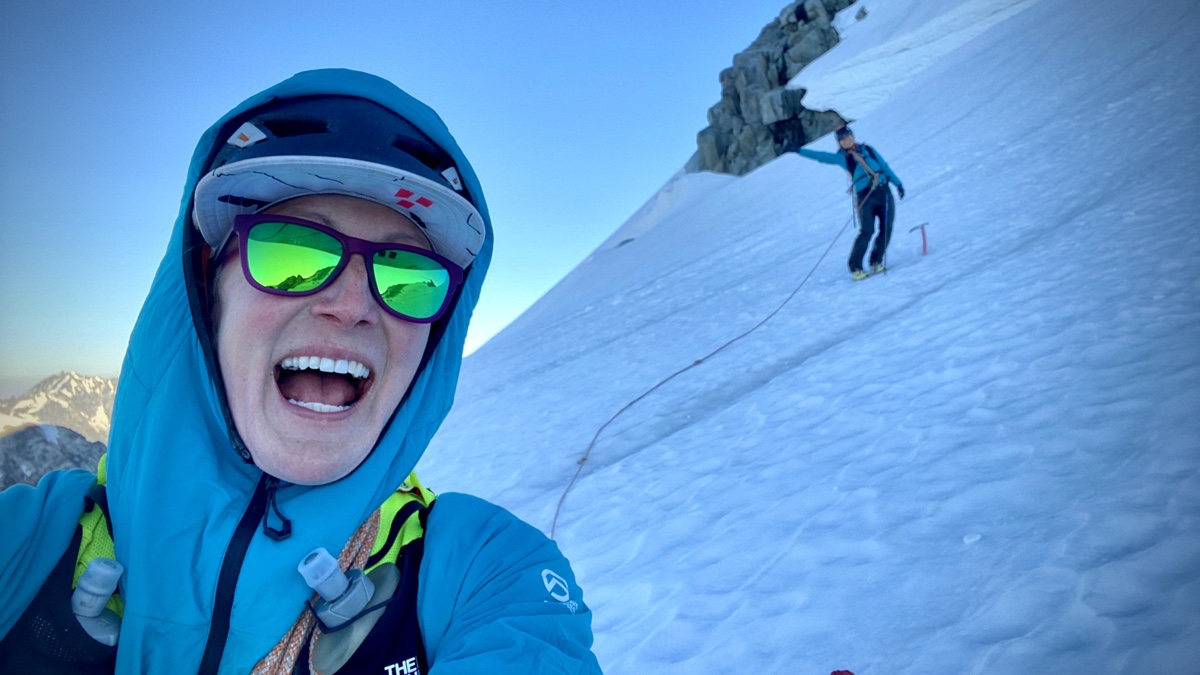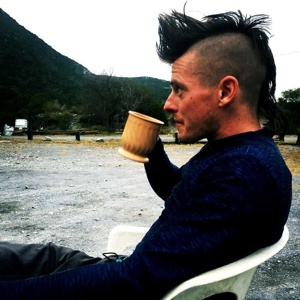As the sun began to set over Washington state’s North Cascade mountains on July 16, 2022, climber Jenny Abegg and ultrarunner Kaytlyn Gerbin plunged into the wilderness — intent on sending the entire mountain range. On an ASAP basis.
Sound wild? Well, that’s exactly what it turned out to be. Beginning near the Canadian border, the adventure covered 124 miles and a bone-crushing 59,000 feet of elevation gain. To construct a route, the two athletes linked up four existing North Cascades traverses, including roughly 100 miles of “true off-trail alpine travel in rugged and remote terrain.”
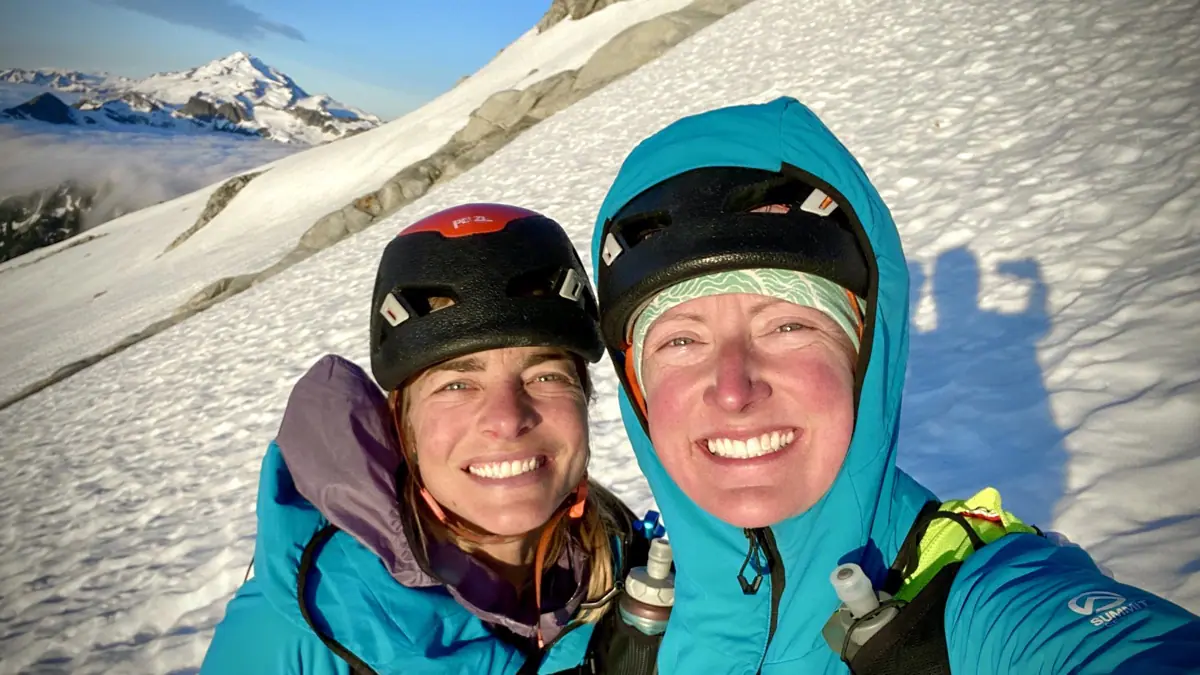
A mid-adventure selfie with Jenny Abegg (left) and Kaytlyn Gerbin on the North Cascades High Route. Photo: Kaytlyn Gerbin
They reconciled the maps, dialed in their gear, and beat tracks to a ranger station to secure the necessary backcountry permits — for “the entire North Cascades,” Gerbin joked.
They called the objective the North Cascades High Route and launched into the effort. When the smoke cleared six days and 19 hours later, they’d not only established a formidable and serious mountain traverse but also pulled off a whale of an adventure.
It all started when Gerbin summoned the idea into reality — after she and Abegg had happened to entertain it separately a year earlier. Abegg was living near the Canadian border when she first mused on a major line that would link up the North Cascades. But she never acted on it, whereas Gerbin did.
Gerbin invested multiple seasons in a prolonged planning, logistics, and scouting stage that effectively became her full-time job. And the ambitious final project served as the spark for an exciting new partnership.
A Tale of Two Skill Sets
By the time of the North Cascades High Route trip in the summer of 2022, the two athletes had been trying to link up for about a year. In fact, Gerbin had landed on the idea of contacting Abegg after a coincidental close encounter on the other side of the world.
On Feb. 4, 2022, Gerbin grabbed the women’s supported fastest known time (FKT) on Patagonia’s storied La Vuelta al Hielo, running alongside Fernanda Maciel — only to see Abegg go out a few days later, needing only two extra hours to do a similar but non-identical variant of the route unsupported and alone.
So Abegg stood out to Gerbin from the get-go. And when the two women started to interface, they realized they could complement each other’s knowledge gaps. Like attracts like, but the inverse also characterized the two athletes’ mutual attraction.
“I need to be really good friends with my partners, and I knew right away that Kaytlyn and I had a great dynamic. She’s totally dialed in ways that I am not, necessarily,” Abegg, a Senior Editor at iRunFar’s sister site Switchback Travel, told me. “We met up in spring [2022] at Washington Pass for this bike-ski-climb thing. The way that she packed her bags, and packed her bike, and talked about snow conditions, overhead hazard — all sorts of things — she’s whip-smart and really well trained.”
For Gerbin’s part, she was hunting a high-acuity rock climber like Abegg. The ultrarunner felt comfortable with the magnitude of work the route would require but knew she needed to onboard technical wherewithal for segments with fifth-class climbing and ridgeline traverses.
“I put in a cold call over Instagram,” Gerbin recalled. “It was, ‘Hey, we have some mutual friends. I heard you’re rad.’ We connected after that, and she was all-in on the project.”
She said the Washington Pass outing made it “immediately evident” that the two could fill the skill gaps they were both vulnerable to. The outing generated an unshakable trust between the two athletes and sealed the partnership.
Their North Cascades High Route outing was on.
White-out Conditions and a Shiver Bivy
Abegg and Gerbin started the route on the business end. Their entry point, off Ross Lake just two miles shy of the Canadian border, led straight into some of the remotest terrain they’d cover.
“Just us, the mosquitoes, and the bears,” Gerbin muses in The North Face’s documentary of the effort. The women then observe there’s “zero trail” that leads anywhere — and lean into 12 solid hours of bushwhacking.
“No trails after that, either. No trails at all! What are we doing out here?” Gerbin cracks.
That’s the general bent of the project. I don’t know if poison ivy lives in the North Cascades, but if it did and I tried Gerbin and Abegg’s route, I would be a walking red rash.
Glaciers and white-outs presented myriad challenges and delight to the two runners, who kept a peppy spirit early on. Still, they thought navigation would be so much easier if they could see. The trek wore on, and the two athletes stayed socked in by the heavy fog.
But the route was long, and conditions would vary widely. After 19 hours of movement on the third day, they found themselves at Luna Col, an overlook Abegg described as “the most beautiful place I’ve ever camped.”
“We could look out at where we’d come from and see the ridgeline that we had traveled. It was epic! We’d come so far and covered such technical terrain. But then we could also look south and see where we were going. And it was kind of this feeling of, ‘What the heck are we doing?’” Abegg said. “That and, ‘Well, we’re doing it.'”
Not long after that, the athletes found themselves mired in their first (and only) spat of the trip. Day four dragged, and after 20 hours on, Abegg and Gerbin found themselves benighted on a complicated ridgeline with temperatures dropping.
Abegg’s climber background conditioned her to prefer a “shiver bivy” and wait it out until morning light. But Gerbin, the ultrarunner, was trained to keep pushing through the night.
There was a designated resupply location only a couple hours downhill, in Gerbin’s estimation. At it was a cozy van; there was even a mattress in the back, where they could rest their rapidly swelling legs. Why not just gut it out and get there?
A dispute ensued, which was to both test and vindicate their partnership.
“Being an ultrarunner that’s pretty comfortable and confident moving in the dark, my mindset was, let’s just push through. We’ll get a full night’s sleep, and we’re going to be warm. I’m like, I don’t care if we get there at 4 a.m. That still seems more worth it to me than setting up a tent, then being freezing cold in it,” Gerbin said.
Abegg recalled becoming “snarky” as the two decided to continue onward.
“It’s hard to resolve things when you’re both hungry and tired and cold. We discussed it a few times, and I pushed us to keep moving forward,” Gerbin said.
But it wasn’t to be. Gerbin gave way to Abegg’s perspective when she noticed an inefficiency familiar to anyone who’s pushed the limit of nocturnal exploration.
“We got to a point where we were both just fumbling around in the dark woods on this ridgeline,” Gerbin recalled with amusement. “We’re not navigating well, we’re not moving efficiently. I was like, ‘Jenny, you’re right. We just need to hunker down.’”
Gerbin said the ability to make decisions under pressure while exhausted often boils down to communicating directly and with respect. Even if it’s an ongoing thread of 10-second conversations, she said, kicking the can down the road will not help. The women’s ability to hash it out was key.
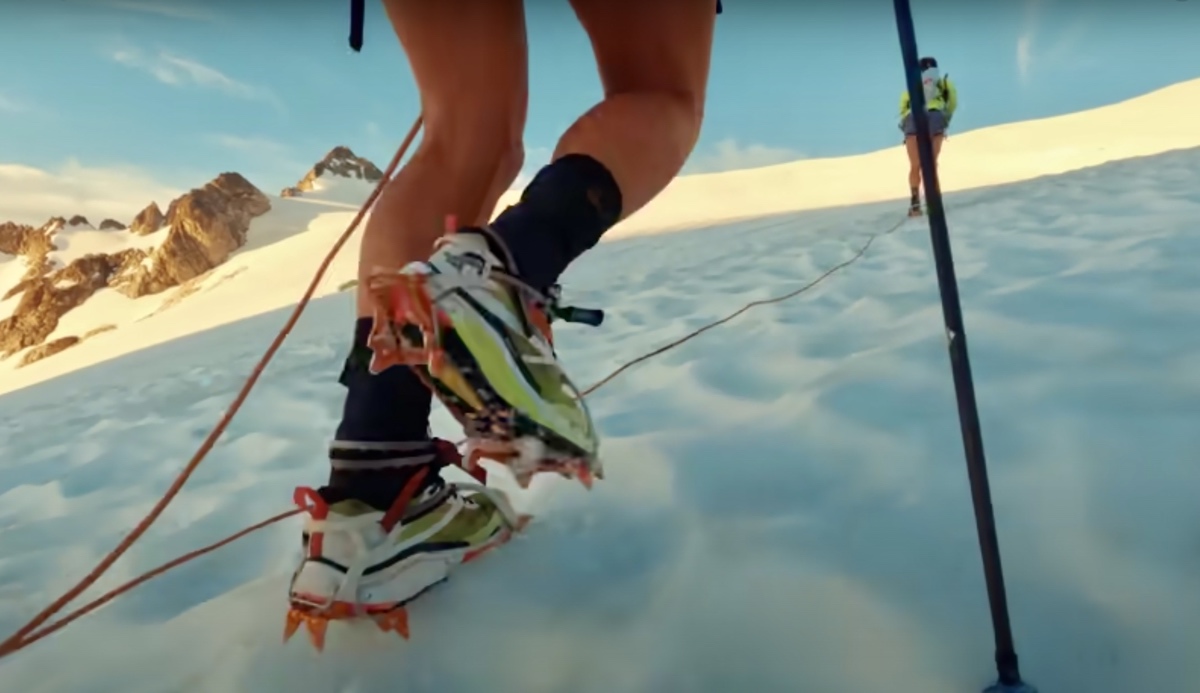
The North Cascades High Route required a diverse skill set — and some different gear from most trail running adventures. Image is a screenshot from the film “The High Route.”
Party Time and ‘Writhing’ Wildlife
Soon, they’d reach their longed-for van and resupply spot, leaving the choppiest, remotest terrain behind them. That’s when the party started. Joined by a cadre of videographer friends plus their significant others, Ely Gerbin and Michael Hutchins, the two athletes soon began harvesting a certain giddy energy with an invigorating effect.
Asked about the source she and Gerbin tapped, Abegg said, “exhaustion?”
Laughing, she went on, “I think we were so enthralled [with the project]. In those seven days, I didn’t think about anything else — my home life, work, any of that stuff. In every moment, I was completely present with the task at hand. There’s a distillation of emotion that’s not clouded with all the other junk of life on objectives like that. You’re just like, ‘Oh, we’ve been going for five days, and my legs are swollen, my shoes won’t fit anymore, but my friend just made a joke, and it was really funny!’”
Episodes of varying abrasion and ickiness took place. There’s footage of Gerbin butt glissading in running shorts, which she told me was no big deal but will likely strike most as … unenviable.
Then, the two encountered a repulsive pestilence. Gerbin and Abegg both described a densely vegetated passage during the first half of the route with a reputation for insect swarms. Expecting mosquitoes thick enough to block out the sun on a head net, the two packed along the recommended equipment.
They wouldn’t need it. Instead, they found an infestation of caterpillars. “Millions upon millions” of them, Gerbin said, hatching — coating the bark of every tree and shrub they forced their way through while bushwhacking. In no time, the women had caterpillars squirming all over their bodies. On their faces, caught in their hair, tumbling into their shirts.
“It was dis-gusting,” Gerbin said with emphasis. “They’re writhing all over the bushes you’re fighting your way through. All over you, everywhere.”
“It was the worst physical moment,” Abegg said. “I mean, there was a night where my legs were so sore, they twitched and convulsed the entire night. It pushed me to the brink. But being covered in writhing caterpillars was so much worse.”
All in the name of mountain exploration.
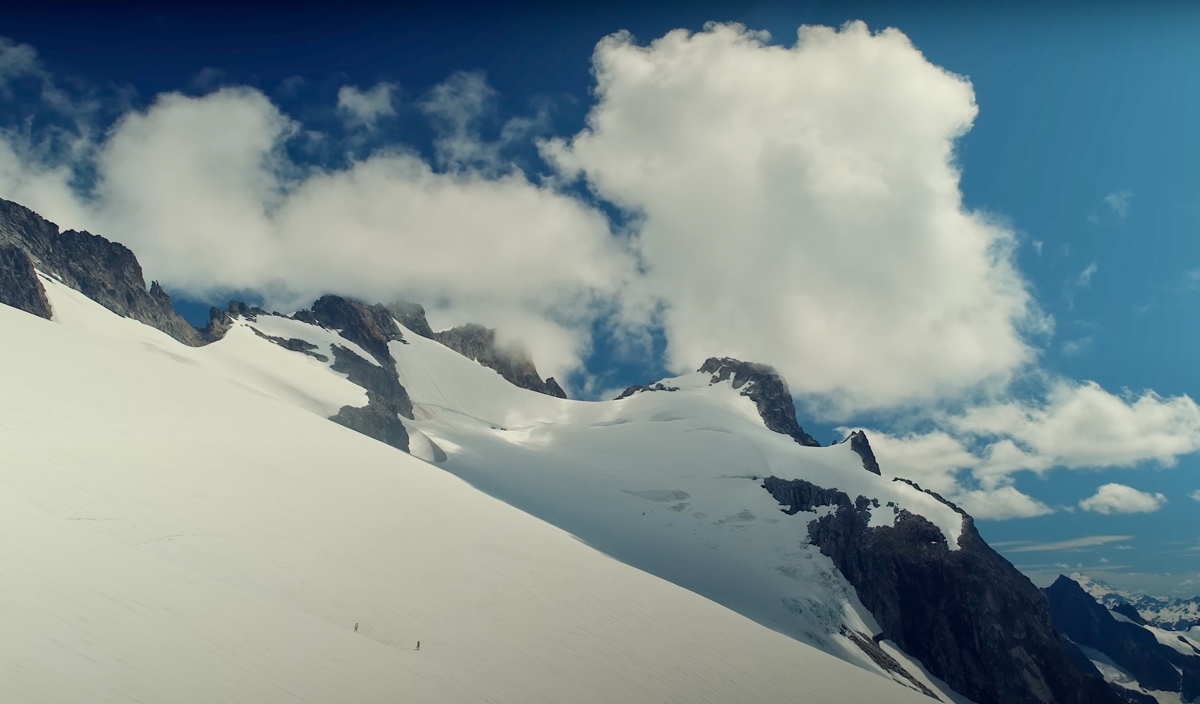
Little humans in a large landscape on the North Cascades High Route. Image is a screenshot from the film “The High Route.”
An ‘Only Known Time’ and a Rending Farewell
The overwhelming creatures’ density caused one detour when an opportunity to go around another swarm presented itself. And other than that, the team encountered few time impediments. It’s a testament not to the pursuit of the record books but to Gerbin’s planning and their joint teamwork en route that they met their initial seven-day goal.
Both athletes confirmed independently that an FKT was never the point. Since the only other group to ever try it did not time themselves, Abegg said, her and Gerbin’s campaign produced an “only known time.”
“The scale of this route, to do it in this fast and light style — shaving a couple hours or a couple days off felt irrelevant. We had goals and timelines, but it was always based off how much food we had and how much farther it was to the next resupply spot,” Gerbin explained. “That drove our pace; more so than thinking, ‘Oh, someone else can do this part faster.’”
Gerbin hopes establishing the route will give more people a chance to see the rugged, unspoiled beauty the North Cascades has to offer. But she did emphasize that there’s another side to all the sentimentality and stoke.
“I get pretty excited when I think of people who travel the world to seek this terrain out, realizing there are cool lines like this in Washington state,” she said. “At the same time, hesitation is not the right word — but it’s challenging to share the scale and seriousness and consequence of some of this terrain. It’s not to be taken lightly.”
She recalled the months she’d spent coaxing the massively complex route into reality, sometimes so anxious about the risk of a certain section or obstacle that she couldn’t sleep. She mentioned the labyrinthine Picket Range, where travelers could find sparse choke points in tall, sheer cliffs plugged with snow or overhung by deadly seracs.
“I’d really hate for someone to get in over their heads,” she said.
After almost seven days of managing objective risk, solving problems, and navigating through caterpillars and all other hazards, Gerbin and Abegg still hadn’t had enough. By the time they reached their prescribed endpoint, they both wished they were still on the trail.
Abegg renders a touching voiceover at the end of the documentary, saying, “It’s sad not to be able to keep being out there together.” The partners reach the finish line in Stehekin and slam-dunk a fencepost with all four hands at once.
So don’t sleep on Kaytlyn Gerbin and Jenny Abegg. There’s wishing you could still be out on the trail, and then there’s the initiative that gets you back out there. While both partners said the afterglow of the North Cascades High Route still feels strongly satisfying, it’s clear it’s not their last hurrah.
“We have a few ideas [for what to do next],” Gerbin said slyly.
Call for Comments
- What did you think of the film?
- Have you been on parts of the route this pair traveled?
- Has this film caused you to think about the big adventure possibilities which are right out your door?
